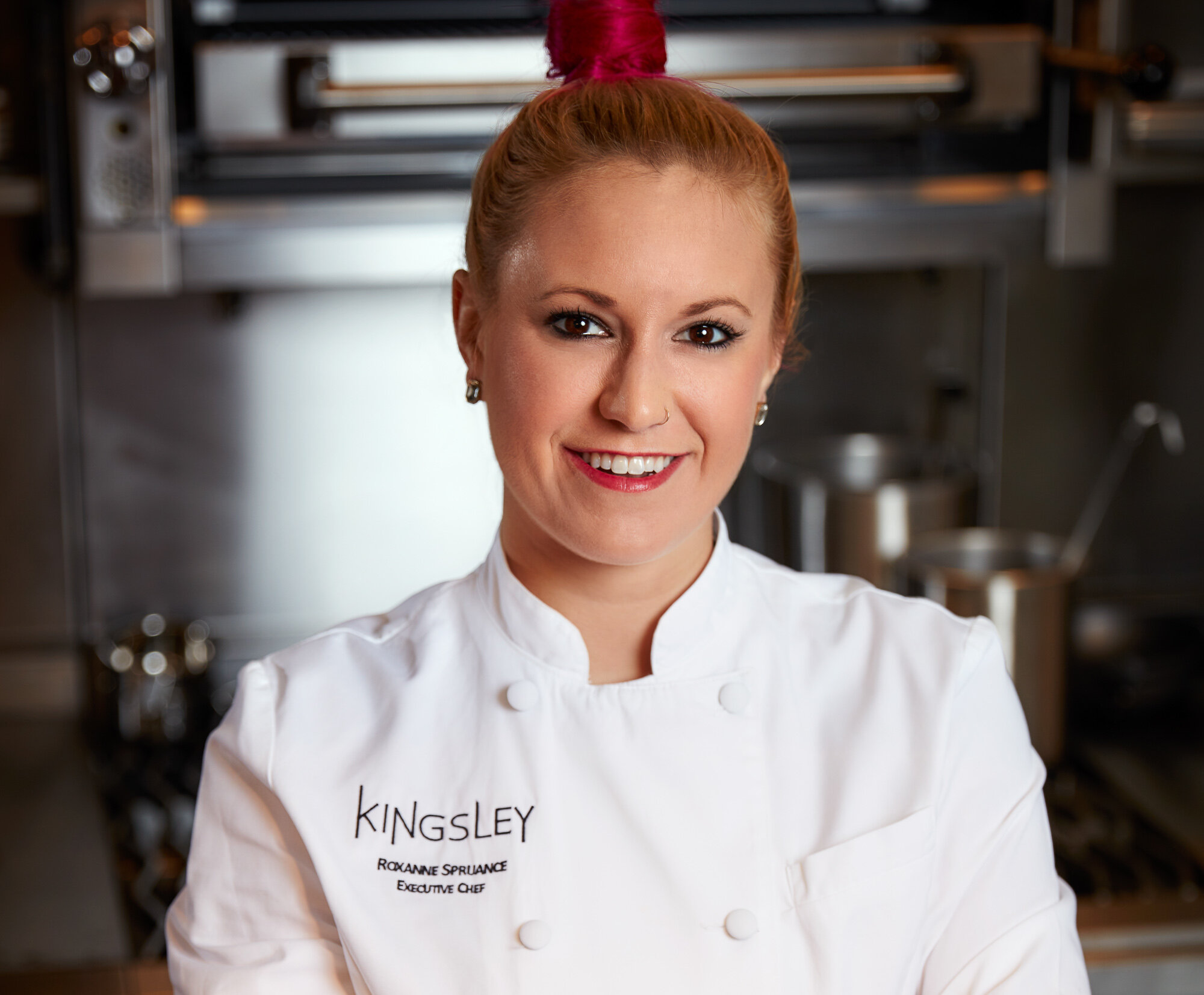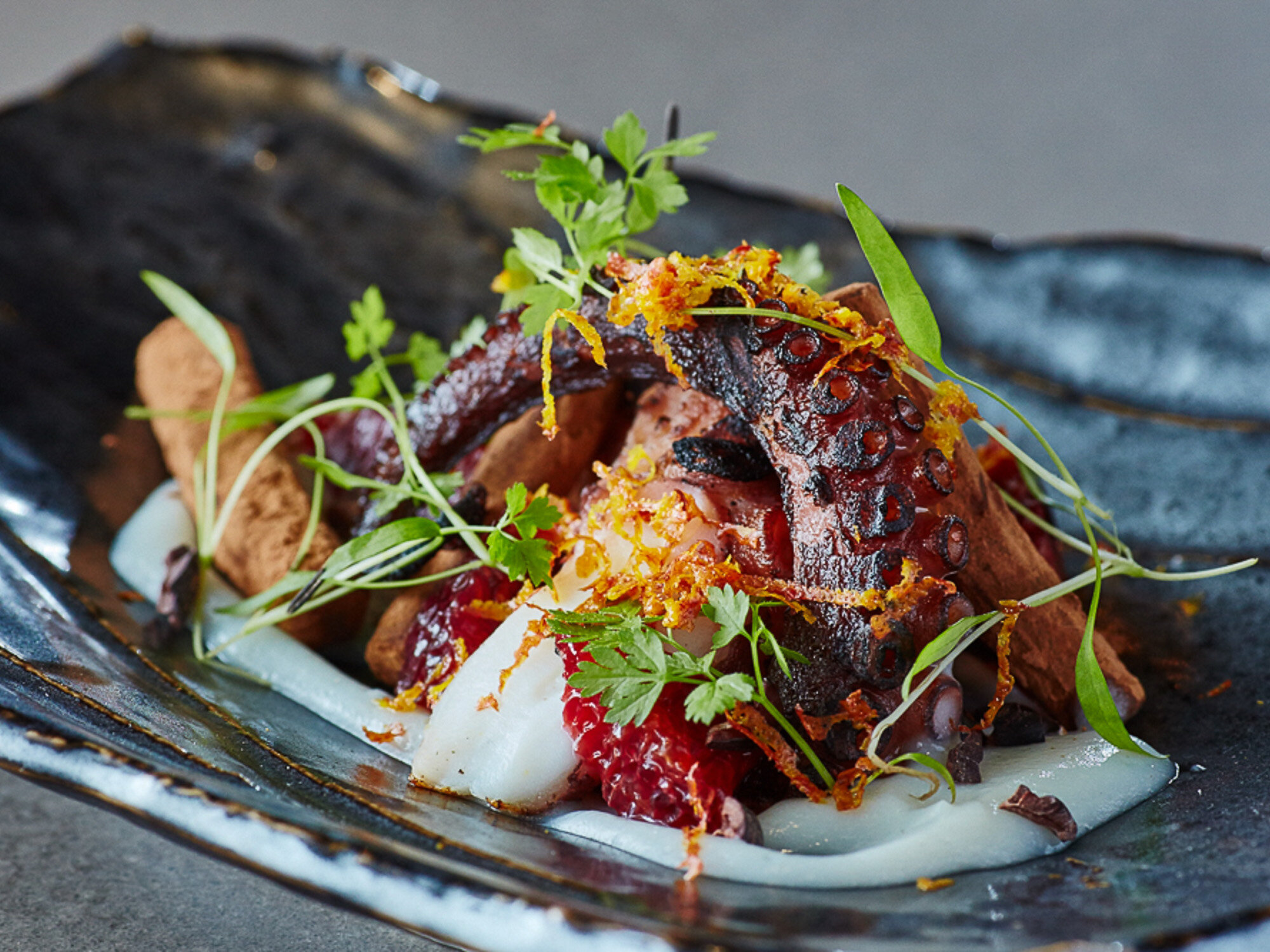At Kingsley, Chef Roxanne Spruance Makes It Work
I take most interviews with chefs over the phone.
I've done my research and crafted my questions beforehand. While they speak, I'm simultaneously typing, following their line of thought, tracking if the questioned I'd asked is being adequately answered, and moving the conversation to an even deeper, more personal place when possible. There is little time to process the world they describe. When transcribing the interview later on, I'm in their dining room, crafting what will be their story. A human being takes shape in front of me.I've needled my way into an interesting facet of journalism. By not reviewing or critiquing restaurants but, rather, focusing on the people who create them, I get to see a space or a menu or a specific dish or cocktail through their eyes. Details I might not notice as a consumer make their way to the forefront if they're of importance to the chef. A plate of octopus is not just a plate of octopus; it's the sum of training and experience and marketing habits.I only dine at maybe 10% of restaurants I work with. I'm about people more than food, so this statistic doesn't irk me. When I do, I'm all about eating the food, not analyzing it. People are questions and histories and passions and conflicts: food is pleasure and sustenance and experience.All this is to say that I've not yet been to Kingsley; because I'm seldom on Avenue B, it's not a restaurant I would most likely stumble upon. But after speaking with chef Roxanne Spruance, I have a feeling it will join the 10%. Because the menu and ethos are the kinds of things I can personally get behind. When I dine out, I want to eat food that fills and fulfills me. I want it to nourish me physically and soulfully. I want to exchange smiles with a server. I want an insanely yummy cocktail and a crispy, charred octopus tentacle.You won't be hearing about my experience at Kingsley. 'Cause, again, that's not what I do. Instead, take a peep at it through the eyes of Executive Chef and partner Roxanne Spruance. Then go see for yourself.
At Kingsley, Chef Roxanne Spruance Makes It Work
Describe opening Kingsley. How did you go bout finding the space, and deciding what parameters you’d set for your menu?
I looked for the space for a long time; we looked at six or seven different spaces. I wanted something with good bones, with walk-in ventilation and all the basic stuff so we wouldn’t need to spend money on build out. We hit the jackpot with this place. Because we did our due diligence looking for it, there were really not a lot of concessions that had to be made. There are three different rooms, which we initially thought it was going to provide a challenge but instead has been amazing: we use the back room as a semi-private dining room, and the front two have their own vibes, and then there’s a garden in back. Each room is 25 seats or under, with a bit more in our PDR since the tables are bigger. It’s an awesome way to use the space.
How did that prep bleed into setting up your menus?
The menu and bar programs came around organically, and they go hand in hand. We are very market-driven, so we have a very collaborative kitchen between me, the bar manager, and my sous chef. We have an ingredient-based bar program; we get a lot from the market for both the kitchen and the bar. Everything has kind of formed itself from this initial vision, which in a nutshell was allowing guests to get amazing food and great service without having to get dressed up and go uptown. There are so many mid-range to cheap eats in this city, but you go in and the servers kind of make you feel like you’re doing them a favor by being there. I hate that feeling.
How does this market-driven idea come about on a plate? And a glass?
When we come up with a dish, it’s about making it composed, balanced, and structure. We’re not gonna throw a poached egg in a bowl with some vegetables and call it a day. Where’s the crunch, where’s the acid? We look at all elements together.One of the few dishes that’s still on from our opening is our Celeriac Agnolotti. It’s a really good example of what we do--not necessarily the risks that we take, but in thinking outside the box. It’s celery root, sunflower, mesquite, and foie gras. There’s no pasta. We roast the celery root whole in salt. When it’s cool, we slice it really thin on a deli slicer. We stuff that “pasta” with a sunflower puree. And it has a mesquite cake (almost with a ginger quality to it) that we break apart so that it’s dehydrated, and it goes on that with seared foie gras, black pepper gastrique, and sunflower shoots. It’s sweet, bright, fresh, and crunchy. Other things change seasonally, like our Octopus and our cocktails. We wanted to change up one of our signature Herb de Provence Manhattan. So now we’re doing a peach, pecan, and bourbon Manhattan of a pecan washed bourbon with peach simple syrup.We’ve only been open for eight months now. We started off strong in the winter, so now the biggest difference is that this is our first full-on market season. It’s really depressing going to the market in the winter; you can only get so excited about root vegetables for so many weeks. So it’s fun that we have this stuff going on. We’re doing huge menu changes right now, and it’s exciting to have our first summer going on.
Why decide on a separate bar food program? What’s fun about that?
We have a spirit-forward cocktail program. You’re gonna wanna eat something when you have two or three of our cocktails! So it’s snackier so that people can run in, have a drink, and leave. I wanted to make it so that this was a bar as well as a restaurant (as well as an event space and patio). That you can do what you want, and it covers all those different facets without being a pretentious restaurant bar that you wouldn’t want to be at. We put a concrete bar and spent forever finding these super comfy bar stools to serve that.As far as the bar menu goes, we break down whole animals, so we have a lamb tartar, we do chicharones with our pigs, and soon I’m gonna do an awesome country French pate. We run it until 1am, since it’s a great cocktail neighborhood where people are out late, but most places don’t really do good late food. So to offer some snacks to people later in the evening that are still curated and not just pizza is important to us.
Speaking of whole animals, how did that come about? It’s hard to break down whole hogs and lambs and such in small New York spaces.
The animals were non-negotiable, just like the farmer’s market is non-negotiable. We were going to make it work. We have two walk-ins and a wine cellar. It’s vertically challenged, but we have horizontal space. There’s a lot here to offer.The way that my food works: I’ve run other people’s kitchens, I know how much money I can make and what a profitable kitchen is. I’ve got the numbers game down. So, one thing to do with whole animals and the market is that it’s a ton more labor but it’s free, because it’s me! If I can get a Heritage pig for $3 a pound rather than just racks or chops that are $30 a pound, it’s a huge difference. And I don’t have to buy skin or shoulders for grinding meat, or roasting for stock.The same goes with the market: it’s cheaper, better, and fresher to get local and seasonal rather than having it shipped in, and the shelf life is longer. Having a place where we have perishable products, you have to figure out what is and is not worth buying. It’s about what you can get out of it, and where you can get the most value out of something. For me that’s doing whole animals. Say I had a super tiny fridge: I’d bring it in and butcher it that day so that it fits in that fridge. There are no limitations, you just have to be a bit more creative about it.
Your history with whole animals goes back to your formal education, too. What leg up do you think that gives you as a chef?
It’s nice to be able to have that background and talk to the farmers about it. Having that education coming in; having that background and mentality, and coming from the Midwest where it is just what you do is invaluable. Having that baseline has only allowed me to learn more and more quickly. It’s awesome to be able to talk to my guys about what’s running, how many tags are left for striper season, what’s going on with spawning where with this weather, what’s happening in Judson Valley versus Jersey versus Pennsylvania.For example, I just got a super pregnant striped bass last week, and I’m now looking into how to make bottarga from striped bass row. They’re huge. I was shocked. They’re huge rosebacks. I took a picture, and my Bangladeshi busser was like, “What are you doing with that? Can I take that home, we eat that.” And I was like, “Yeah, man, go at it.” That’s what’s so cool about getting stuff in that’s whole: it’s not scaled and gutted, so you get a lot more stuff to play around with. I’m making terrine out of lamb tongue. We have hearts and brains. You get more and, if you’re comfortable using it and selling it, it’s awesome.
What’s the greatest takeaway for your team, working under your tutelage?
The biggest thing I want them to learn is time management and their day’s structure. I have two cooks in the kitchen, my sous chef on the line, and then a porter/prep person during the day. I’ll bring another on in the fall when we get super slammed again. It’s one of those things when you have a to-do list and you get to work and you have a whole day to do a billion things. But if you have half a day you’ll get it done. That’s what I try to instill; it’s not about you coming in earlier, it’s about you working efficiently. Efficiency is something I like to teach because they can take it with them forever, whether they stay in this industry or not.And thinking outside the box; doing the basics, and then thinking outside the box. I think you should be able to braise short ribs before you can make a foam five different ways. The only reason why you get to play around is because you know the science behind things and because you know the basics. Without the basics, you cannot move forward. And with that, it’s this efficient attention to detail, and consistency. I want that salmon cooked the exact same way every single time. I want octopus cooked the same every single time. I want to know that if I’m not here, what is expected of our kitchen is going to be done to T.I wanted a smaller space where we could control what we’re doing. There’s always something that can go wrong, so if you figure out how to mitigate the human error between FOH and BOH, you’re in a place where you can handle ups and downs and what’s thrown at you because you have a baseline structure for what’s in place.
You have a really rich culinary background we could pick apart, but who / what work experience in your past is most at play now at Kingsley? What do you do on your menu now that you might not be able to execute without that particular training?
There are two different avenues here. The first restaurant was Blackbird in Chicago, the year they opened 1998. They put me in pastry. It was unpaid. But that’s where I fell in love with restaurants and what they could do. Paul [Kahan] was doing French-based seasonal food, but I had been working for Rick Bayles at Topolobampo doing Mexican for years. It taught me that you take these snippets and have this amalgamation of voices. Then it was working for Christian Delouvrier and getting the basics down, when I was 22 and making his sauces; I thought was just surreal.And then wd-50! I think there was a common misconception of how it was all molecular and just this crazy stuff. But 99% of what Wylie [Dufresne] was thinking about was, “How do I organically manipulate these ingredients in a different way?” Like putting a hot dog bun through a pasta roller to put around a crab roll. It wasn’t all this crazy stuff. It’s more of, “What can I do with this? How can I present this flavor that people are familiar with in a different way?” That was really enlightening and it was very inspirational for me.
A weird consideration for chefs nowadays is how their plates will be photographed by Instagram-crazy diners. How seriously do you consider visual composition?
I don’t think about people taking pictures when I plate. It’s a combination of what the dish is, how it speaks to me, and what plate it’s going on. The heirloom tomato salad has compressed honeydew melon in these upside down circles, next to these baby green tomatoes, so it’s a play on what that tomato would be. I’m a fan of negative space, and I’m a fan of round plates, since sharp angles don’t draw your eye anywhere. I look for how color works on a canvas – it’s the same thought process. I like round plates, so we do a lot with the curve of a plate. It’s an organic process. There’s obviously a time and a place for abstract shit, but it shouldn’t make your eye work. I think that’s part of how people identify with your dishes: they’re not having to figure out what the thing is. There’s no contrast with what they’re trying to eat. It’s a little bit subliminally less stressful for your eye.
You’ve worked extensively both in Chicago and in NYC. Why are you still here? What about the dining scene / other restaurants / the way people eat is satisfying for you? Challenging?
I was definitely set on going back to Chicago. I know my baseline, what my costs are, and what my rent is. I can’t swing a crazy rent.But part of it was that I’ve been here for seven years now, and have made amazing connections. So to go back to Chicago and that scene would be fine, but a big transition. And if you can get your construct in New York…. Regardless of what people think about food cities all over the world, New York City is this hub. To get proof of a concept here is something. It lets you do whatever else you want down the road. I get everybody jumping ship, and moving out. If I hadn’t found this spot in this neighborhood… it’s amazing here, every storefront is independent, you feel this sense of community, and I’ve never had this anywhere else in this city. Everything else, you’re getting pushed out for huge corporate places and there’s no heart anymore. That’s why we’ve resonated so well: every day we create new regulars, and we have people who have been coming every week since we opened. That’s a special thing and testament that we’ve put our heart and soul into that, and the message is clearly conveyed. You don’t get that in a lot of places.
I know this restaurant has been on your mind for a while. What about it feels particularly personal?
I’ve worked just as hard at every other restaurant I’ve worked at. And when I started at 15 years old in Chicago at Blackbird, it was always “my restaurant.” It’s not just about where you work; it’s ownership, which I try to instill in my employees. It’s not just my name on the door.Honestly, I try not to think about it all the time, but there is something to be said about sitting down at the end of the night, in a space that is my name. It’s awesome. I designed the whole thing from the ground up. Some girls plan their wedding -- I planned this restaurant. I had pictures of bathroom tiles from years ago that I sent it to all these tile guys. I knew I wanted a poured concrete bar. Being a chef, you’re a visual person already. I had a vision of it being neutral, clean, and an inviting space. That’s absolutely what we created. It was a plug-and-play, in a sense. I knew exactly what the color scheme was going to be. My contractor knew I was going to be super hands on. It’s funny when you look back at it, doing these “half-ass” renderings, and it turns out to look exactly like what we had planned.



